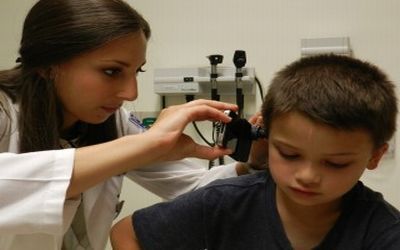iPhone Attachment Designed for At-Home Diagnoses of Ear Infections


A new pediatric medical device being developed by Georgia Tech and Emory University could make life easier for every parent who has rushed to the doctor with a child screaming from an ear infection.
Soon, parents may be able to skip the doctors visit and receive a diagnosis without leaving home by using Remotoscope, a clip-on attachment and software app that turns an iPhone into an otoscope.
Pediatricians currently diagnose ear infections using the standard otoscope to examine the eardrum. With Remotoscope, parents would be able to take a picture or video of their childs eardrum using the iPhone and send the images digitally to a physician for diagnostic review.
Wilbur Lam, assistant professor in the Wallace H. Coulter Department of Biomedical Engineering at Georgia Tech and Emory University, along with his colleagues at the University of California, Berkeley, is developing the device, with plans to commercialize it.
Ultimately we think parents could receive a diagnosis at home and forgo the late-night trips to the emergency room, says Lam, who is also a physician at Childrens Healthcare of Atlanta and an assistant professor of pediatrics at Emory School of Medicine. Its known that kids who get ear infections early in life are at risk for recurrent ear infections. It can be a very big deal and really affect their families quality of life.
Remotoscope's clip-on attachment uses the iPhone's camera and flash as the light source as well as a custom software app to provide magnification and record data to the phone. The iPhones data transmission capabilities seamlessly send images and video to a doctor's inbox or to the patient's electronic medical record.
The device has the potential to save money for both families and healthcare systems, Lam says. Ear infections, or otitis media, affect 75 percent of children by age 6, making it the most common diagnosis for preschoolers. They result in more than 15 million office visits per year in the United States and thousands of prescriptions for antibiotics, which are sometimes not needed.
At the initial visit with a patient, physicians say it is difficult to differentiate between ear infections caused by viruses, which resolve on their own, and those caused by bacteria, which would require antibiotics.
As pediatricians will likely only see the child once, they often err on the side of giving antibiotics for viral infections rather than risk not giving antibiotics for a bacterial infection, which can lead to complications, Lam says. So, we are currently over-treating ear infections with antibiotics and consequently causing antibiotic resistance.
Lam says Remotoscope may be able to change physicians prescription patterns of antibiotics for ear infections. Receiving serial images of a childs ear over several days via the Remotoscope could allow physicians to wait and see if a childs infection improves or whether antibiotics are warranted.
A clinical trial for the Remotoscope is currently under way to see if the device can obtain images of the same diagnostic quality as what a physician sees with a traditional otoscope. The Food and Drug Administration, through the Atlanta Pediatric Device Consortium, is partially funding the trial.
Fourth-year Emory medical student Kathryn Rappaport, who is part of the research team, is recruiting families who come into the emergency department at Childrens Healthcare of Atlanta hospitals for treatment of ear infection-type symptoms. Once a family agrees to be in the trial and the child has seen the emergency room doctor, Rappaport takes video of the childs ear with
Remotoscope and a traditional otoscope linked to a computer. Next, a panel of physicians will review the quality of the samples, make a diagnosis from the Remotoscope video and see if it matches the original diagnosis by the ER doctor.
As part of the clinical trial, Rappaport is also conducting a survey asking parents their opinions on using the device.
A lot of parents said they would want to use it, which surprised me because I think it could be scary to look in someones ear and because I think parents would be afraid they could hurt their child, Rappaport said. Parents are enthusiastic and ask me where they can get it, but were not there yet.
The research team hopes to publish the trials results by the end of the year and then study whether the Remotoscope enables physicians to implement the watchful waiting plan rather than prescribing antibiotics right away.
Remotoscope has had a long journey with many players to get to where it is today. Lam and a colleague, Erik Douglas, started the project while doctoral students at UC, Berkeley. The two researchers went on to create the startup CellScope Inc., which aims to commercialize Remotoscope once clinical studies are complete and the device has FDA approval.
In 2011, when Lam joined the faculty at Georgia Tech and Emory, he brought the project with him to Atlanta. Today resources from both institutions, as well as Childrens Healthcare of Atlanta and the Atlanta Clinical & Translational Science Institute, are being used to take the medical device to the next level.
The Remotoscope is one of nine medical device projects supported by the Atlanta Pediatric Device Consortium, which is a partnership among Georgia Tech, Childrens Healthcare of Atlanta and Emory University. The consortium, one of four in the U.S., provides assistance with engineering design, prototype development, pre-clinical and clinical studies and commercialization for pediatric medical devices.
The whole goal is to create, develop and commercialize pediatric medical devices specifically for kids, Lam says. Kids are not just small adults. Physiologically they are different. So to only have medical devices scaled down from adult ones creates this void where there are many diseases that affect only the pediatric population but there are not any available devices to treat them.
For more information on the Remotoscope, visit: http://pediatricdevicesatlanta.org/remotoscope
Source:Georgia Institute of Technology
From the Derby to the Decontam Room: Leadership Lessons for Sterile Processing
April 27th 2025Elizabeth (Betty) Casey, MSN, RN, CNOR, CRCST, CHL, is the SVP of Operations and Chief Nursing Officer at Surgical Solutions in Overland, Kansas. This SPD leader reframes preparation, unpredictability, and teamwork by comparing surgical services to the Kentucky Derby to reenergize sterile processing professionals and inspire systemic change.
Show, Tell, Teach: Elevating EVS Training Through Cognitive Science and Performance Coaching
April 25th 2025Training EVS workers for hygiene excellence demands more than manuals—it requires active engagement, motor skills coaching, and teach-back techniques to reduce HAIs and improve patient outcomes.
The Rise of Disposable Products in Health Care Cleaning and Linens
April 25th 2025Health care-associated infections are driving a shift toward disposable microfiber cloths, mop pads, and curtains—offering infection prevention, regulatory compliance, and operational efficiency in one-time-use solutions.
Phage Therapy’s Future: Tackling Antimicrobial Resistance With Precision Viruses
April 24th 2025Bacteriophage therapy presents a promising alternative to antibiotics, especially as antimicrobial resistance continues to increase. Dr. Ran Nir-Paz discusses its potential, challenges, and future applications in this technology.